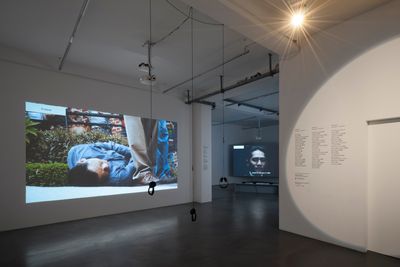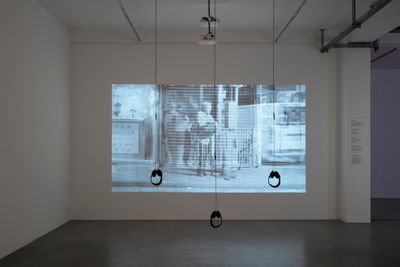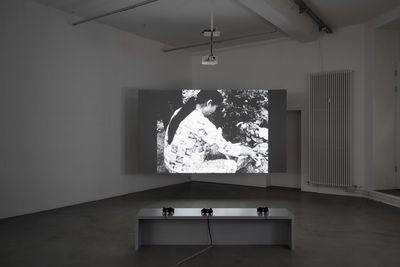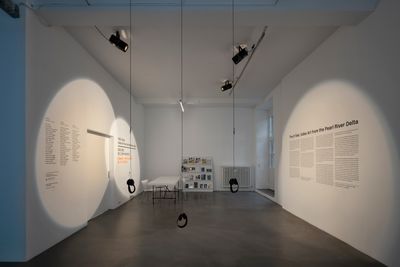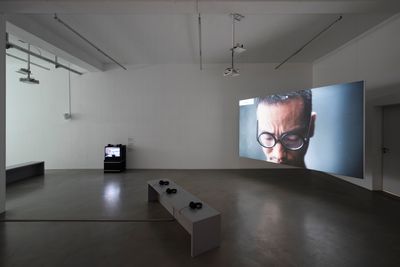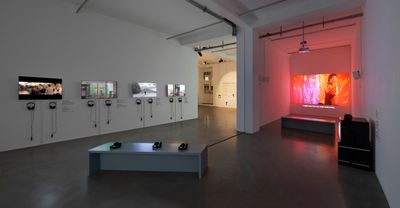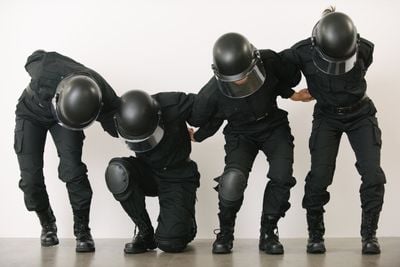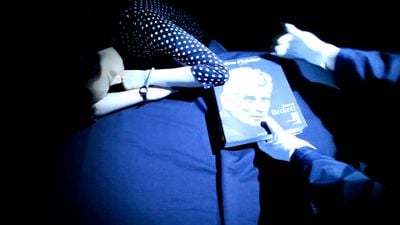Xi Bei
Xi Bei. Courtesy Times Art Center Berlin.

Xi Bei. Courtesy Times Art Center Berlin.
Times Art Center Berlin is a non-profit art institution located in the Potsdamer Strasse Art District of Berlin. It was founded in July 2018 by the Guangdong Times Museum, a non-profit private art museum in the Pearl River Delta (PRD) region of China, making this the first parallel institution founded overseas by an Asia-based art museum. Its inaugural exhibition, The D-Tale, Video Art from the Pearl River Delta, curated by Hou Hanru and Xi Bei, opened on 30 November 2018, and runs to 13 April 2019. The exhibition includes 56 artists and nearly 90 artworks that have been organised into three consecutive episodes: Urban Explosion (1 December 2018–12 January 2019), Towards Autonomy (18 January 2019–23 February 2019), and The Politics of the Self (1 March 2019–13 April 2019).
The exhibition as a whole features works by artists who originate from or now live in the PRD region, such as Cao Fei, Samson Young, and Jiang Zhi. International artists who have either experienced the PRD as residents or in passing include João Vasco Paiva, Simon Denny, and MAP Office. The artists featured come from different generations, ranging from vanguard Cantonese video artists from the mid-1980s like Ellen Pau, to emerging artists from China who now live and work in Berlin, such as Isaac Chong Wai. In terms of form, the videos featured in each episode range from animation and essay films to documentation of performance and instructional pieces. Such diversity of artists and forms is intended to demonstrate how the artists in the show have been able to create 'personal utopias', offering an escape from the strain of the overwhelmingly rapid growth that has defined the PRD.
The Guangdong Times Museum places a strong emphasis on its connection to the Pearl River Delta, which includes the cities of Guangzhou and Hong Kong. The PRD is among the fastest growing regions of China—both economically and in terms of population—and one of the most densely populated urban regions in the world, with a 2015 World Bank report finding that the PRD had overtaken Tokyo as the world's largest megalopolis. Founded in 2010 by Times China Holdings, a Chinese property development company, and located within a residential apartment building in Guangzhou, the Guangdong Times Museum is uniquely situated to examine the changes in the region and document urbanisation's effects. The core tenets of the Museum are research, experimentation, and dialogue, with most exhibitions being research-based and including a discursive programme. 'Southern Theory' is a key idea driving the Museum's work: a methodology aiming to build a new concept of modernity relevant to the Global South, in this case related to the particular circumstances of the PRD. This involves contextualising global changes through local and regional urban and artistic developments.
In her text 'Where is the Dragon Boat Going?—New Institutional Geographies of Our Times', Nikita Yingqian Cai, chief curator of the Guangdong Times Museum, emphasises that the aim of 'Southern Theory' is not 'to reiterate the geographic division or socio-cultural hierarchy between the South and the North', but rather to situate 'the Museum in a rich and complex constellation of Southern narratives and imaginaries by negotiation between global capitalism and local forms of resistance.' In the same text, Cai uses the analogy of rowing a dragon boat down the river as a means to describe the importance of enabling histories to come through into the present, or, as she puts it, enabling the 'kindred, vernacular, manual, pre-industrial' to pierce through the 'universal façade of modernity.'[1] This image draws on both the collective effort that rowing a dragon boat requires and the sport's geographic specificity to Southern China.
In many ways, Times Art Center Berlin is an extension of these ideas. As noted by Xi Bei, the Center's artistic director, the space intends to present works of art from the PRD to Europe, albeit with a PRD perspective, thus creating a space for conversation between East and West that is not dominated by Western paradigms. While many of the programmes and exhibitions of the Times Art Center Berlin will be informed by the methodologies of the Guangdong Times Museum, and some will be in direct collaboration with this institution, Xi Bei insists that the Center is also looking forward to growing with and within the artistic ecologies of Berlin. In this conversation, Xi explains the origins of the Times Art Center Berlin and how it hopes to forge its place within city and global contemporary art discourse.
PCWhat is the thread of circumstances that led you to the Times Art Center Berlin? What from your life will help readers understand your vision for the space?
XBI am based in Berlin and consider myself a Berliner. Before I lived here, I was a Parisian for 16 years. As a Chinese-born exhibition organiser, I have had the chance to work within curatorial teams of numerous exhibition projects in Europe and Asia, such as the 2nd Guangdong Triennial, the 10th Biennale de Lyon, the 10th Istanbul Biennial, the Chinese Pavilion at the 52nd Venice Biennale, the 7th Bi-city Biennale of Urbanism and Architecture Shenzhen, among others. From my work and life experience, I would call myself 'Eurasian'. It is this plural experience that enabled me to develop a vision and to further set up Times Art Center Berlin.
PCWhat potential do you see in Times Art Center Berlin's format as an 'experimental contemporary art space' rather than a museum, in terms of how you define its mission and relationship to its audience?
XBMy team and I are very inspired by Berlin's openness and hyperculturality. With our programme we are aiming to contribute to that very specific and inspiring atmosphere. I am working with quite a small but efficient team, which gives us the possibility to be very flexible. A museum often has a fixed hierarchical structure. An experimental art space gives you broader capability to experiment, to try different things out, and to leave the sometimes very rigid structures of a museum.
Since the start, I was interested in working with artists and curators in Berlin who have diverse cultural backgrounds. The diversity of our collaborators allows us to dig really deep into different spheres and look at subjects from different angles. Besides my team in Berlin, we are working very closely with curators from the Times Museum in Guangzhou, as well as its director. With this amazing and diverse team, we aim to create a platform that is open to artists and curators from China, Asia, and the rest of the world. We are aiming to open a window and create a space for exchange.
For our first exhibition, which features three episodes, we are showing video art from China that might not be completely familiar to people living in Berlin. This gives the audience here the opportunity to change their perspective, or just to nuance their understanding of contemporary art from China, which is often stereotyped. Having said that, we are also aiming to highlight the relationship between individual and social dialogues of global cultures. Through that focus, we aspire to create a vision inspired by alternative modernity, or rather modernities—a fluidity of identities. I think the audience in Berlin is very open to such an approach because of its interest in building more global discourses.
PCThe Guangdong Times Museum was founded with a particular emphasis on thinking through urban and economic developments and challenges in the Pearl River Delta region. Thinking about how the Berlin and PRD metropolitan zones are so fundamentally different—not only in size and population, but also in their economies and politics—what does it mean to communicate between the PRD and Berlin on urban issues? What relationship do you envision the Times Art Center having with Berlin?
XBThe PRD region is the low-lying area surrounding the Pearl River. It's the area where the Pearl River flows into the South China Sea and is one of the most massively urbanised regions on this planet. The PRD has a long history of international trade and migration; but it has also been politically and culturally marginalised by central China, and was once dubbed the 'factory of the world'. Until the 1990s, Rem Koolhaas undertook research with students and named the PRD a city of 'exacerbated difference in the age of globalisation'. Hou Hanru considered it 'an experimental cultural space'. Since then, the PRD has become a more intriguing cultural location, including for contemporary art.
Concerning your question on the communication between the PRD and Berlin: I think that both places have undergone tremendous changes since the end of the nineties. Both places have become hubs for contemporary art and seem to exist in a state of constant flux, which of course brings both positive and negative aspects, such as gentrification.
There are several parallels, but also diversities I can see here, and where enrichment from both cultures or cities can happen. While our inaugural exhibition is about video art from the Pearl River Delta, the curatorial approach is not restricted to urban topics in the PRD. On the contrary, we endeavour to construct a new platform with a unique background, which can react to and interact with the political, historical, and cultural complexities of Berlin.
PCOne of the central concepts of the Times Museum is 'Southern Theory', which aims to develop South-based ways of thinking about contemporary issues, including in and through contemporary art. How do you see your vision and the work of the Center connecting to this concept?
XBSince its inauguration in 2010, the Guangdong Times Museum has been focusing on constructing a critical sphere around the cultural landscapes of today's China by promoting intellectual discussions in the city of Guangzhou and supporting artistic production beyond the bounds of market constraints. Embracing different ways of 'worlding', Times Art Center Berlin aims to facilitate the migration of aesthetics, cosmology, and materiality across cultures and accommodate encounters, interrogations, and representations of diverse agencies and subjectivities. The South-South conversation and how this can be brought into a place like Berlin is at the heart of our exploration, and we are cognizant of the fact that Berlin, itself, exists between Western Europe and the East. The base we are standing on is a very good and inspiring one.
PCCommunity engagement is another core tenet of the Times Museum's mission and is fulfilled through both the Museum's architecture and diverse programming. How do you plan to reach communities in Berlin, whether those engaged by the art world and those that are not?
XBBerlin is one of the most vibrant cities in the world. For decades the city has been a hub for artists from all over the world. Its diverse infrastructures for art and culture have nurtured institutions of different scales and orientations. What makes Berlin's art communities special is that they actively advocate for multiplicity and heterogeneity in the public sphere. Their critical dynamics challenge the neo-liberal dominance of the art market and encourage long-term, research-based projects and initiatives. As a matter of fact, I think this is one of the aspects that we, as a newly immigrated institution, can learn a lot from. We would like to develop organically in relation to the artistic ecologies of Berlin.
Concerning your question of how we plan to reach the art world in Berlin: I think we have already generated a quite diverse crowd of audience over the last weeks for our first two episodes. It was very exciting for me to see that local Berliners, artists, and institutions, as well as the Berlin Chinese community, were interested in our programme. I am sure there are a lot more community interactions to come, as the Times Art Center puts down roots here in Berlin.
PCYour first exhibition, The D-Tale, Video Art from the Pearl River Delta, curated by Hou Hanru and yourself, examines video art from the Pearl River Delta. What led you to plan this particular show to open the new space? Will video art have a position of particular importance in the Times Art Center?
XBFor this inaugural exhibition, Hou Hanru and I considered that time-based media is one of the most effective ways to communicate the historical, sociopolitical, and artistic identity of this special geographic zone. As a matter of fact, video art emerged as early as the mid-1980s in the region, but it remains lesser known to international audiences. By adopting the medium of moving image, artists from the Pearl River Delta responded to rising political and social tensions, and the ongoing collision of local and global influences. Their video practices represent the most groundbreaking and powerful visions of experimental art and culture in the PRD, reflecting its transient environment as well. As a result, the PRD has become a creative hub for international exchange and art activities, as well as a deviating model that inspires artists from other regions. The exhibition consists of 56 artists with almost 90 works of video art. I see it as a kaleidoscope: the audience catches a glimpse of the PRD through each unique artistic fragment, and the fragments then work together to open more possibilities of geopolitical understanding.
But, as I mentioned earlier, as a contemporary art institution we don't constrain ourselves to any fixed medium or theme. Hence, we also included the Berlin-based artist Isaac Chong Wai's performance piece Rehearsal of the futures: Police Training Exercises 1 (2018) in our opening programme for Episode 1, Urban Explosion. Furthermore, we invited Berlin-based curator David Elliott for a conversation with Hou Hanru on the same evening. The next conversation will be on 23 February and will feature Li Zhenhua, Marie-France Rafael, and Olaf Stüber from Videoart at Midnight, Berlin. In the future, we will engage with many other formats and different artistic practices from various cultural contexts.
PCYou mentioned Isaac Chong Wai's performance Rehearsal of the Futures: Police Training Exercises 1, which took place during the opening of The D-Tale. The work is composed of gestures of police violence from protests and other clashes with the public reformulated into sensual, gentle caresses. The performers, clad in black clothing reminiscent of police riot gear, interacted with each other and with the audience at a decelerated pace, choke holds becoming tender embraces.
Why did you pick this particular piece to accompany the inauguration of the Times Art Center Berlin? What does this performance teach us about the potential perils of public space?
XBIsaac Chong is originally from Hong Kong and finished his studies in the Bauhaus University in Weimar, Germany. He is an artist who belongs to a new, younger generation of Asian artists who study and work in a global context. He is aware of global sociopolitical tensions, looking for artistic expressions and forms of resistance against dominant powers and ideology. His new performance shows a sensibility and tenderness of gestures, which recall human consciousness, turning the potential perils of public space into artistic strategies to construct a personal utopia. The video of his performance will be present in the second episode. As his work reflects on current political and social developments that can be felt globally, his work is of great importance.
PCTitled Urban Explosion, the first episode of The D-Tale, Video Art from the Pearl River Delta featured videos from Cantonese and Hong Kongese natives to the PRD alongside artists from other nations, such as Koki Tanaka and Allora & Calzadilla. Could you speak a little bit about how you chose the works you feature in the exhibition and how the three episodes relate to one another?
XBIt's been an intense process to go through the long list of artists and videos that we wanted to show. All of these videos have a common background and can be labelled as 'made in/for the PRD'. Each has a different approach, perspective, idea, and format: including animated and narrative films as well as those that use more performative or documentary modes. Each artwork has its unique imagination and sensibility. Urban Explosion, Towards Autonomy, and The Politics of the Self are the subtitles of the trilogy. They are three red threads to communicate and differentiate the relationship between all the artworks in the exhibition.
The videos we selected are mainly from PRD artists, such as Cao Fei and Jiang Zhi, as well as individual works from the four members of Big Tail Elephants Group, which was a very influential artist collective in Guangzhou during the 1990s. While their work is mainly known in the context of Chinese contemporary art history, we also included works by artists such as Ming Wong, or Isaac Chong Wai, who belong to a much younger generation of artists. Furthermore, there are videos produced in the PRD by international artists, such as Allora & Calzadilla, Jalal Toufic, and Simon Denny, among others.
I would like to give special mention to the artist Chen Tong, whose work is featured in the second episode, Towards Autonomy. He is quite an outstanding person for the Cantonese art scene. He started creating his own artworks in the late 1980s. In the early 1990s he established Libreria Borges, an independent book store in Guangzhou, which is now known as CANTONBON. Their work focuses on the translation of well-known literature and texts related to arts from around the world. Chen Tong is the founder of Video Bureau, an important institution in the PRD, which has a hub in Beijing and with which he focuses on collecting and displaying artists' works for public consumption. In Episode II, we showed his work Seeing Without Using Eyes (thief version) from 2015. It's his second work about the Libreria Borges Institute for Contemporary Art. In the work, the artist plays the role of a thief who steals documents at night, taking advantage of his contact inside the institute. Through beaming flashlights, handscrolls in safes, and empty filing cabinets, the scattered perspective of traditional Chinese paintings is revealed to us.
PCThe Times Museum in Guangdong has a rich programme of residencies, social interventions, and symposia. Is there anything we should know about the specific purposes that you hope to serve with non-exhibition programming at the Times Art Center Berlin?
XBIn terms of the long-term programming, we plan to organise various exhibitions and non-exhibition programming as the Center develops further. We would like to construct conversations and look forward to collaborating with local institutions, curators, artists, and initiatives. It starts with our inaugural show The D-Tale, for which we will have three panel discussions, one accompanying each episode. For these we will invite curators and art experts from China and Berlin to exchange and share their expertise and vision. —[O]
—
[1] Cai, Nikita Yingqian. 'Where is the Dragon Boat Going? -New Institutional Geographies of Our Times.' Times Museum. Accessed February 13, 2019. http://www.timesmuseum.org/exhibition/view?id=15.


